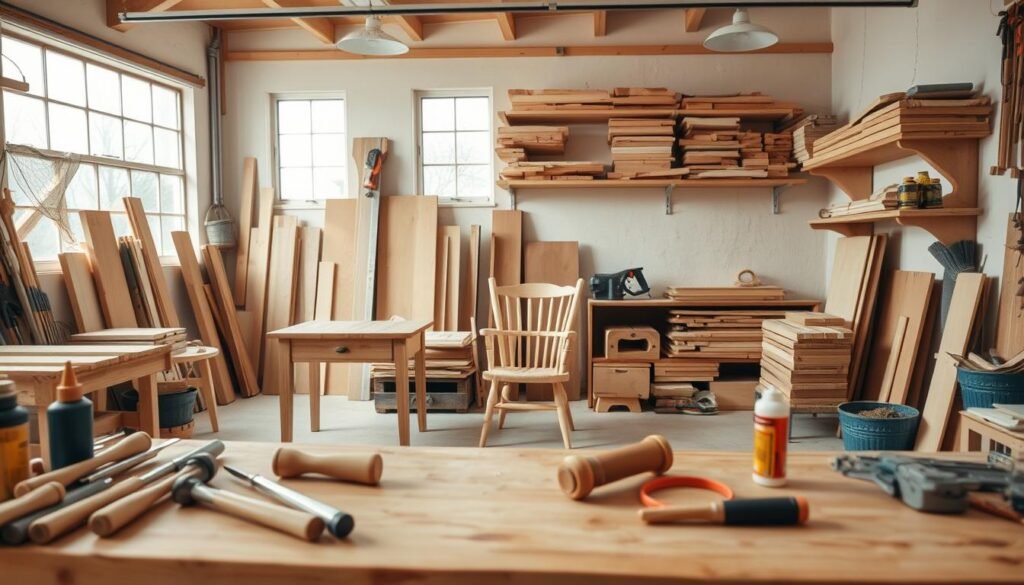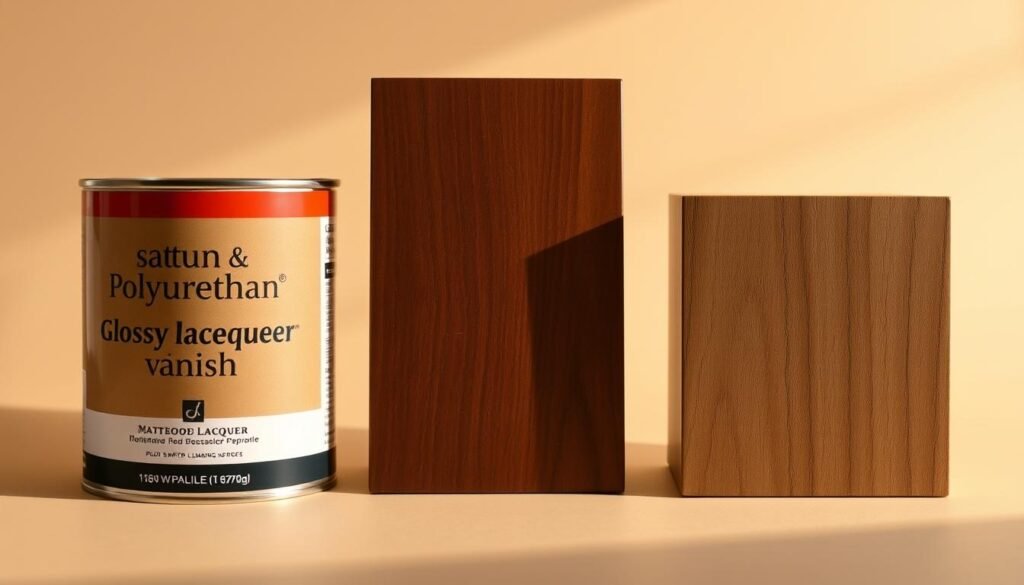Turning your living space into a peaceful and beautiful place is simple. Adding handmade wooden planters to your decor is a great way to do this. They bring natural beauty and let you show off your creativity.
DIY wood planter box ideas are for everyone, from beginners to experts. Making your own planters lets you match them to your space and style. They’re perfect for adding greenery indoors or creating an outdoor paradise.
Working on creative wooden planter projects is rewarding. It connects you with nature and makes your space better. It’s a chance to be creative and enjoy making something beautiful.
The Beauty and Benefits of DIY Wooden Planters
DIY wooden planters mix nature with handcrafted beauty. By making your own, you add a personal touch to your space. This boosts your home’s look and gives you a sense of pride.
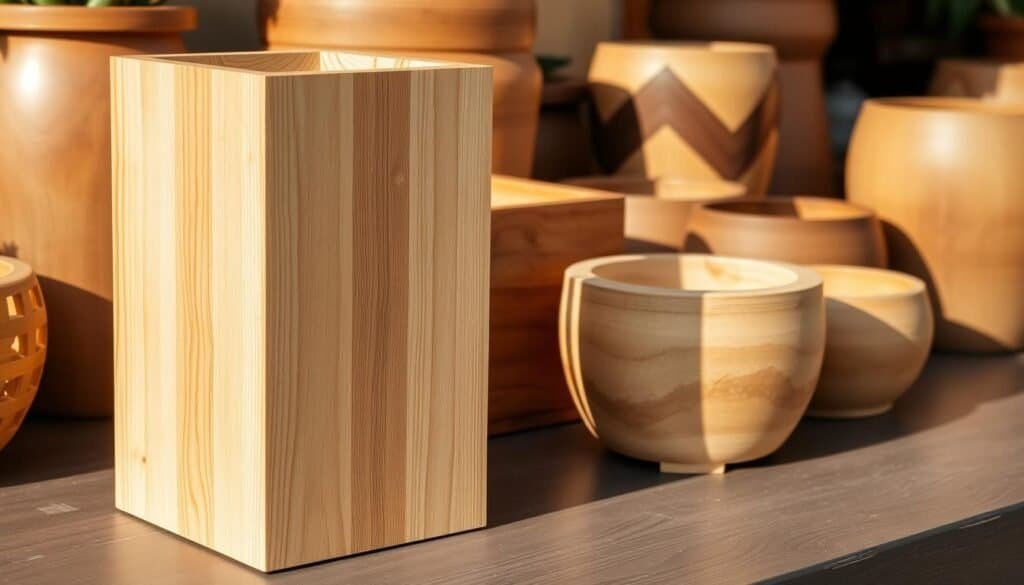
These planters are more than just decorations. They’re durable and can be customized to fit your style. They bring nature indoors, improve air quality, and create a peaceful vibe.
Building your own wooden planters is a fun, rewarding task. Even with simple tools, you can make stunning pieces that show off your taste. It’s a great way to beautify your home, whether you’re experienced or just starting out.
Essential Tools and Materials for Building Wooden Planters
Building wooden planters needs careful tool and material selection. Being well-prepared makes the project fun and successful.
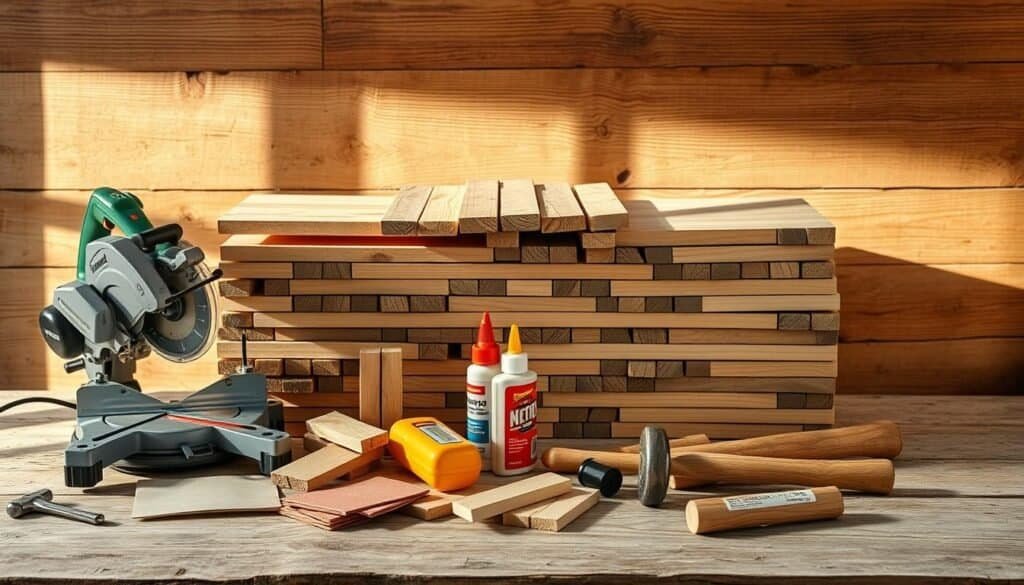
When building wooden planters, you can choose between power tools and hand tools. Power tools like circular saws and drills make work faster. Hand tools, though, give more control and are quieter and cheaper. Your choice depends on what you like, the project’s complexity, and your budget.
Safety Equipment Essentials
Always put safety first when using tools and materials. You need safety glasses, gloves, and a dust mask. These protect you from debris, sharp edges, and sawdust. Having the right safety gear prevents accidents and makes woodworking safer and more fun.
Weather-Resistant Woods for Outdoor Use
Outdoor planters need weather-resistant woods. Cedar, redwood, and cypress resist rot and insects well. These woods make your planters last longer and save you from frequent replacements.
Affordable Alternatives for Beginners
Beginners might look for cheap alternatives to expensive woods and tools. Reclaimed or recycled wood is both affordable and eco-friendly. You can also find beginner-friendly tools that are easy to use and won’t break the bank.
Waterproofing and Maintaining Your Wooden Planters
To keep your wooden planters in good shape, it’s key to know about waterproofing and upkeep. Wooden planters can get damaged by moisture, which might cause rot and decay if not protected.
There are ways to waterproof your planters, like using a sealant or a liner. You should also check for damage, clean them, and make sure the soil drains well to avoid waterlogged soil.
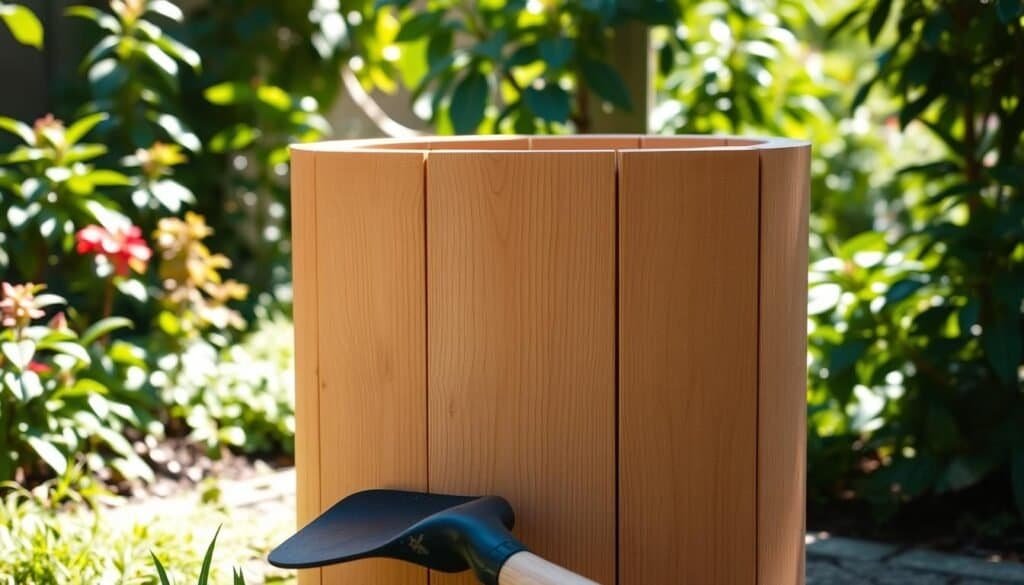
It’s important to check your planters for cracks or splits often and fix them quickly. Also, keeping your planters clean and free of debris helps them look good and keeps your plants healthy.
By following these easy tips, you can make your wooden planters last for many years. They’ll stay in great condition, and your plants will thrive.
Simple Rectangular Wooden Planter Box
Looking for a simple DIY project? Try making a rectangular wooden planter box. It’s great for all gardening levels.
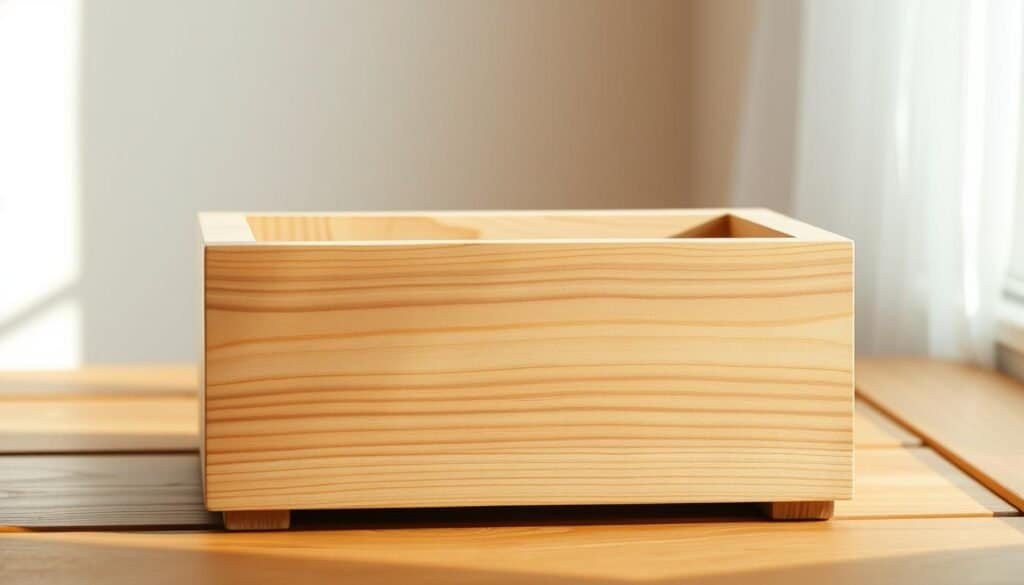
First, cut the wood to your size. For a basic planter, use 24 inches long, 12 inches wide, and 12 inches tall.
Cutting and Assembly Instructions
Cut four pieces for the sides and one for the bottom. Use a saw for clean cuts. Sand the edges to make them smooth.
Assemble the pieces with wood screws or nails. Make sure the corners are tight.
Begin by attaching the sides to form a rectangle. Then, add the bottom piece, ensuring it’s even with the sides.
Adding Drainage Holes
Drill drainage holes in the bottom to avoid waterlogged soil. This is key for your plants’ health.
Place the holes evenly across the bottom. For the mentioned dimensions, two to three holes are enough.
With these steps, you can make a beautiful, useful simple rectangular wooden planter box. It will beautify your indoor or outdoor space.
Rustic Wooden Barrel Planter
Making a rustic wooden barrel planter is a fun DIY project. It can add character to your garden or living area. It’s perfect for showing off your favorite plants and can be made to fit your style.
To begin, find a wooden barrel at a local craft store or online. Ensure the barrel is clean and dry before starting. You’ll need basic tools like a drill, sandpaper, and waterproof sealant.
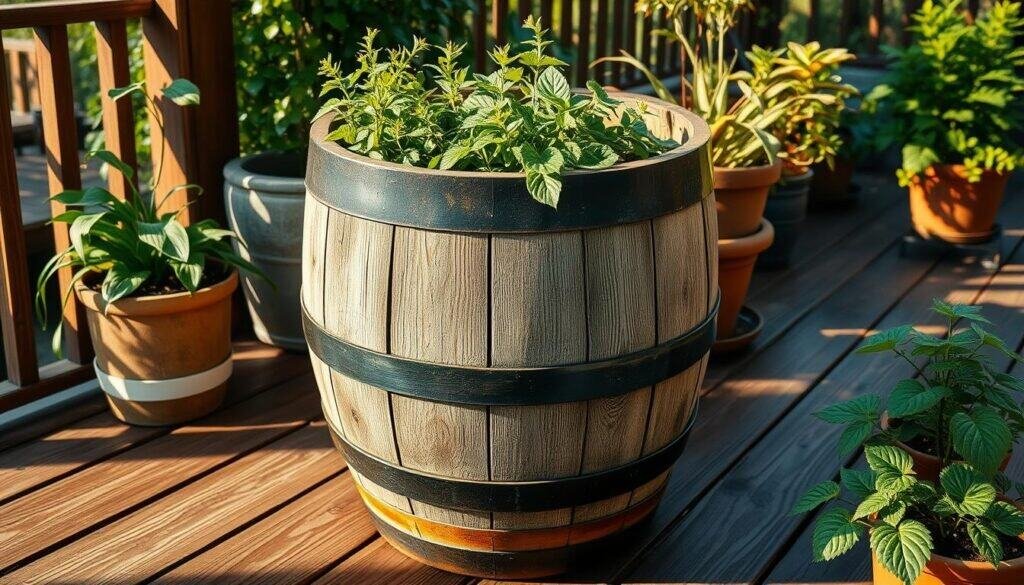
First, clean and sand the barrel to remove dirt or debris. After sanding, apply a waterproof sealant to protect the wood from moisture. Then, add soil and your chosen plants.
To get a rustic look, distress the wood with a wire brush or sandpaper. This will give it a weathered appearance. You can also add metal bands or a wooden lid for extra charm.
A rustic wooden barrel planter brings natural beauty to your space. It’s a great way to reuse and recycle an old barrel. With creativity, you can make a unique and functional planter that highlights your plants and adds character to your home or garden.
Tiered Wooden Planter Stand for Multiple Plants
Building a tiered wooden planter stand is a great way to show off many plants in a small area. It lets you use your space better and brings greenery to your home or garden.
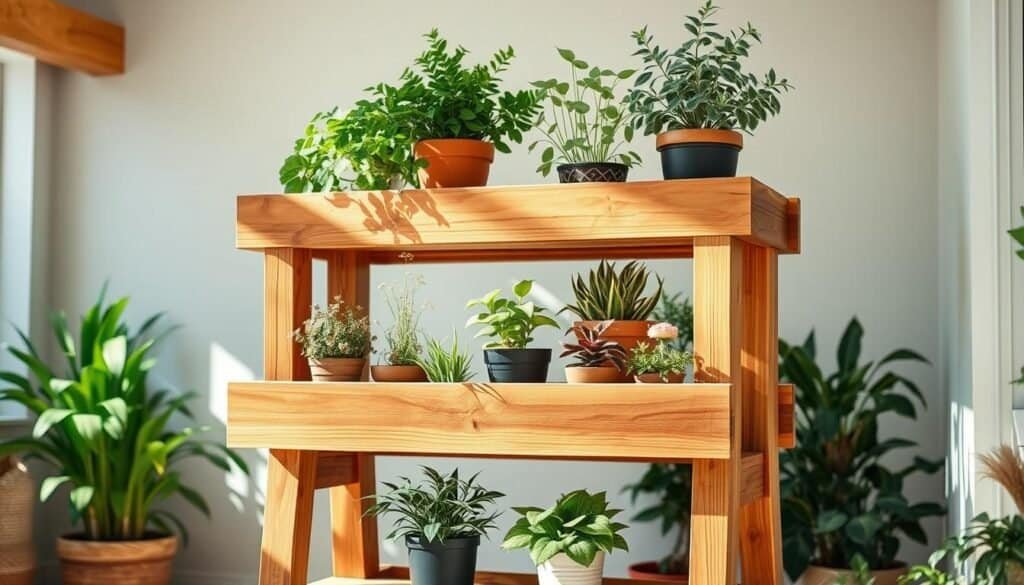
To make a strong tiered planter stand, focus on making stable tiers. Design each level to hold the weight of plants and the boxes.
Creating Stable Tiers
Think about the size and weight of the boxes and plants. Use strong wooden brackets or shelves for support.
Securing Each Level
It’s key to keep each level stable to avoid the stand falling. Use screws or nails to fix each tier to the main frame. This makes sure the stand is solid and safe.
By following these steps, you can make a beautiful and useful tiered wooden planter stand. It will show off your plants and add elegance to your space.
Creative Wooden Planters Boxes Projects Anyone Can Build
Make your outdoor or indoor space better with these easy wooden planter box ideas. Wooden planters bring warmth and coziness to any area. Plus, building them is a fun DIY project.
Building your own wooden planters lets you customize them to match your style. You can pick the wood type, design, and size that fits your space.
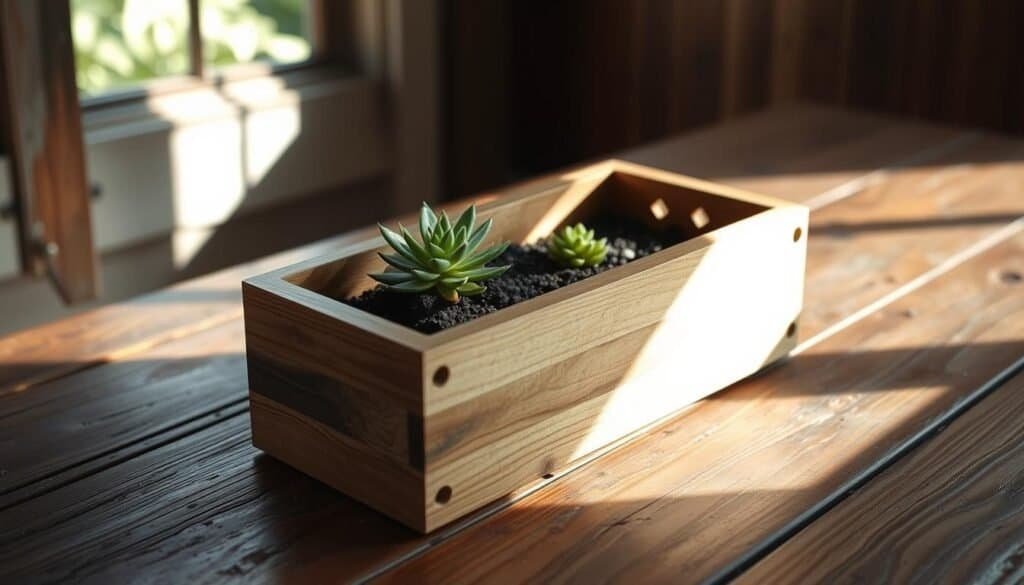
To make your planters special, add decorative touches like carvings, metal straps, or colorful tiles. These details can turn simple containers into stunning garden art.
Incorporating Mixed Materials
Mixing materials in your planters adds texture and interest. For instance, combining wood with metal, glass, or stone makes a unique design. This mix also boosts your planters’ durability.
By trying out different materials and decorations, your planters can be more than just plant holders. They can be the garden or home’s centerpiece. Whether you’re experienced or new to DIY, these projects will inspire you to start building.
Hanging Wooden Planter Boxes for Vertical Gardening
Hanging wooden planter boxes are perfect for saving space. They’re a big part of vertical gardening, which is getting more popular. These planters let you bring nature indoors without cluttering your floors.
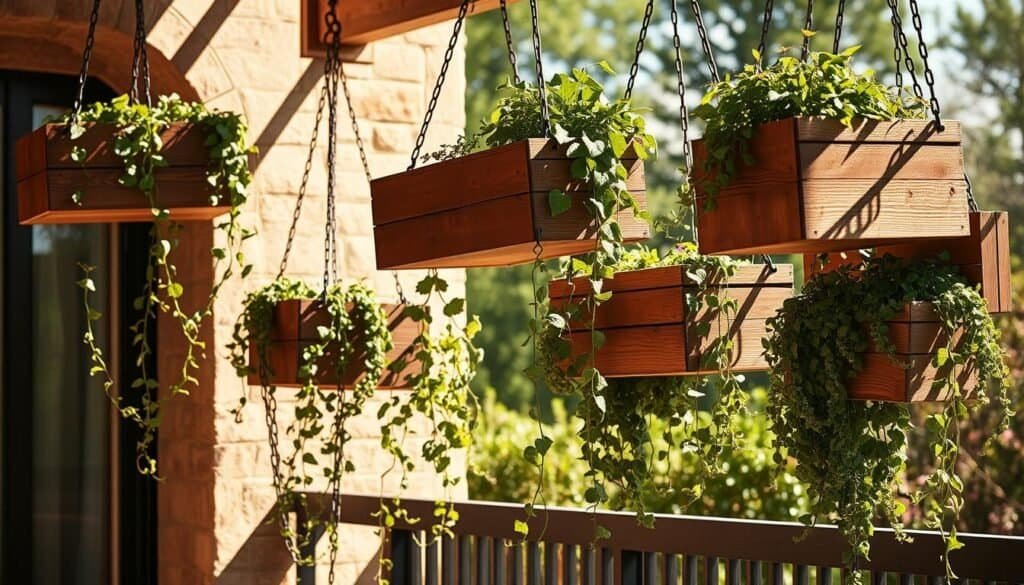
Hanging wooden planters are a creative way to show off your plants. They can turn any room into a beautiful vertical garden. When picking a planter, think about the wall mounting hardware you’ll need.
Wall Mounting Hardware Options
There are many wall mounting options like screws, brackets, and hooks. The right choice depends on your planter’s size and weight, and the wall type. For example, drywall needs anchors for a strong hold.
Weight Considerations for Safety
It’s important to think about the planter’s weight, including soil and plants. Make sure your wall hardware can handle it. Too much weight can cause the planter to fall, damaging things or hurting someone. Always check the weight limit of your hardware.
By following these tips and picking the right hardware, you can enjoy your hanging wooden planter boxes safely.
Upcycled Wooden Crate Planters
Turning old wooden crates into planters is a creative way to reuse materials. It adds a rustic charm to your home decor. This eco-friendly DIY project reduces waste and brings a unique element to your space.
To start, find a wooden crate from local stores or online. Make sure it’s clean and dry before you begin. You’ll need basic tools like a hammer, nails, and a waterproof liner to protect the wood.
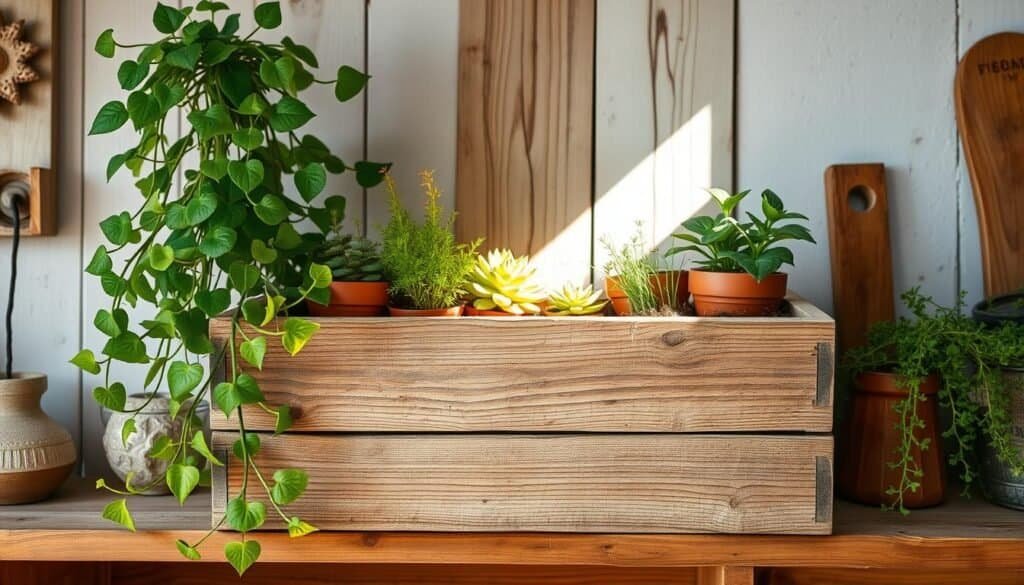
Begin by disassembling the crate if needed and clean it well. Reassemble it if necessary, and add a waterproof liner inside. Fill it with soil and your chosen plants. You can get creative with the arrangement and add decorative elements like paint or stain.
DIY wooden crate planters are versatile and sustainable for displaying plants. You can place them indoors or outdoors, depending on your preference. For more upcycled planter ideas, consider adding a personal touch with decorative items or combining multiple crates for a larger display.
Window Box Planters to Enhance Your Home’s Exterior
Make your home’s exterior more beautiful with window box planters. They add greenery to your windows. This is a great way to make your home more inviting.
There are many types of window boxes, like wooden, plastic, and metal. Wooden ones are popular for their natural look and durability. Pick a window box that fits your home’s style and size.
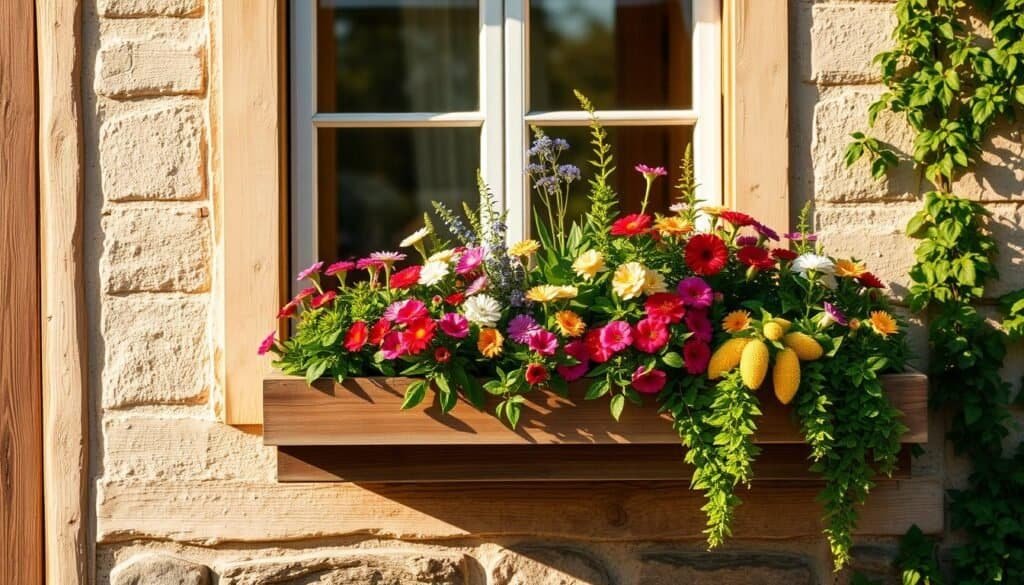
Choosing the right plants for your window box is key. Pick plants that do well in your window’s sunlight. For sunny spots, try petunias, geraniums, or succulents. For shadier areas, go for ferns, impatiens, or coleus.
Installing window box planters is easy. Make sure they’re securely attached to the window sill or wall. Use a potting mix that drains well and water your plants often to keep them healthy.
Adding window box planters to your home’s exterior can make it look better. With the right plants and installation, they’re a beautiful and useful addition.
Mobile Wooden Planter Cart with Wheels
A mobile wooden planter cart is great for any garden or indoor area. It makes moving plants easy and fun. This planter is also very useful for changing up your garden layout.
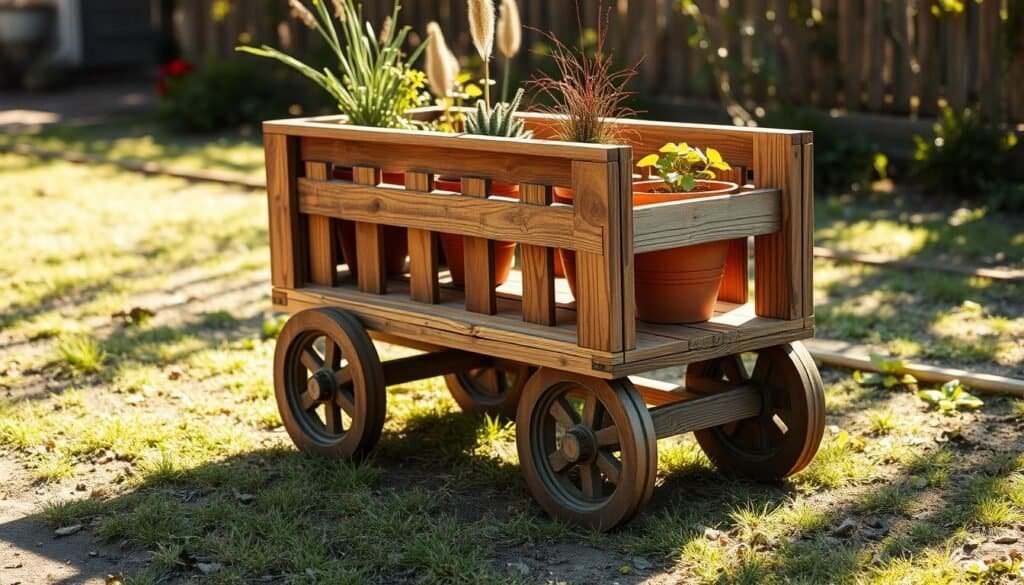
To make a strong mobile wooden planter cart, start with a solid base. Pick the best wood and design a base that can handle the weight of plants and soil.
Creating a Sturdy Base
A strong base is key for your planter cart’s stability. Choose wood that won’t rot or get damaged by bugs. Make sure the base can hold the weight of the planter when it’s full.
Selecting and Installing the Right Wheels
Choosing the right wheels is important for moving your cart. Pick wheels that are strong and can handle the cart’s weight. Also, install the wheels right so they stay in place over time.
By following these steps, you can make a beautiful and useful mobile wooden planter cart. It’s perfect for adding plants to your home or garden.
Geometric Modern Wooden Planters
You can make beautiful geometric modern wooden planters with the right tools and materials. These planters are great for adding a modern look to your garden. They also show off your plants nicely.
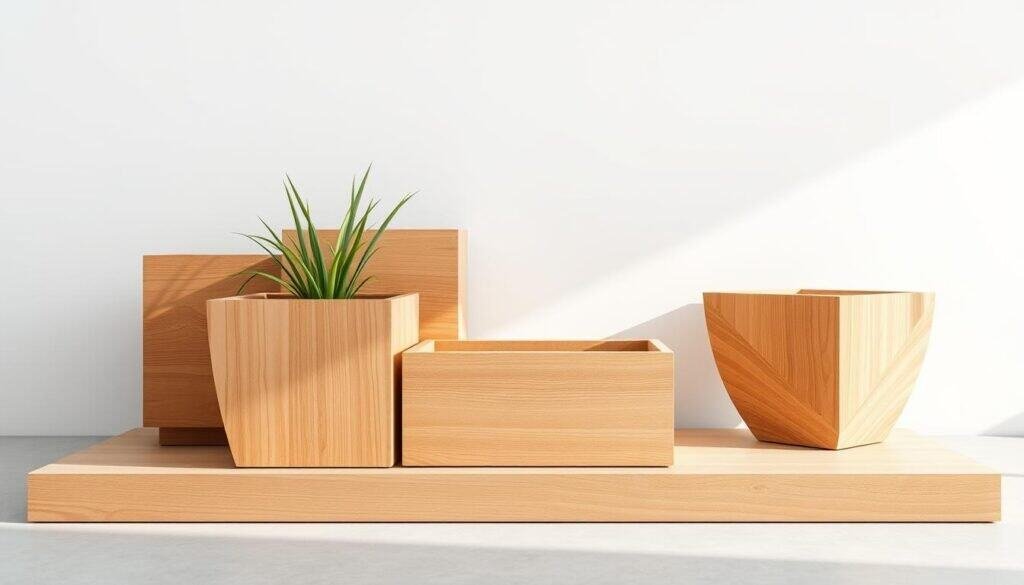
Mastering angle cutting is key to making these planters. Getting the angles right is important for the geometric shapes of modern planters.
Angle Cutting Techniques
To get precise angles, use a miter saw or a circular saw with a miter guide. Cut scrap wood first to check your angles. This way, you’ll know they’re right before you start on your actual planter pieces.
Template Creation for Consistency
Creating a template is vital for consistent shapes. Use plywood or MDF for your template. It helps you mark your cuts accurately on the wood.
With precise angle cutting and a good template, you can make amazing geometric modern wooden planters. They bring modern elegance to any space.
Raised Garden Bed Planters for Outdoor Spaces
Raised garden bed planters are great for making your outdoor area better. They help your plants grow by improving drainage and soil structure. Plus, they keep the soil warmer, which is good for plants.
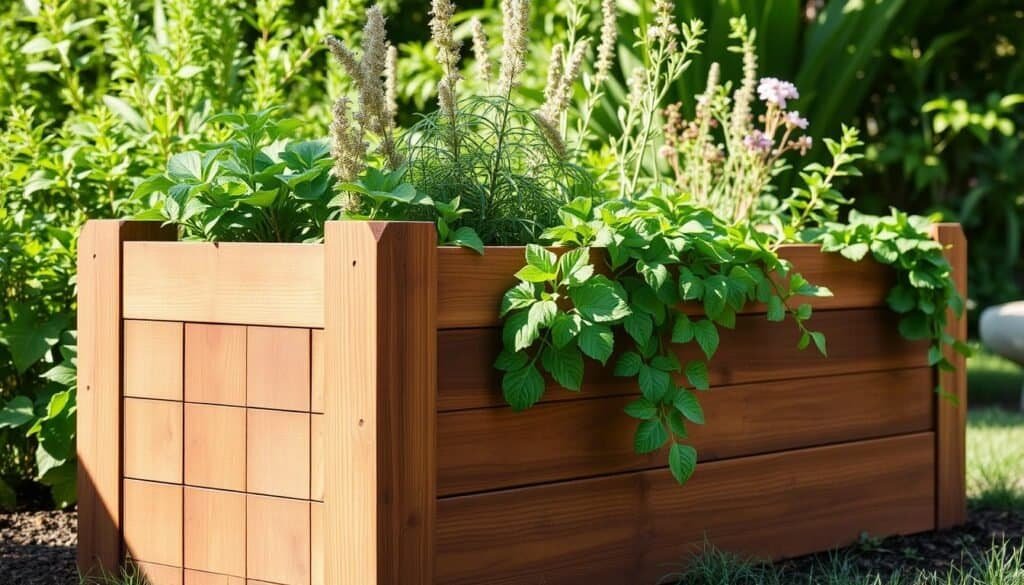
When making raised garden bed planters, think about how strong they need to be. This is important because they have to handle the weather and the weight of the soil. Corner bracing is a key part of this.
Corner Bracing Techniques
Corner bracing means adding support to the corners of the bed. This stops the sides from bowing out under soil pressure. You can use wooden brackets or metal corner braces to keep the corners tight.
Reinforcement for Soil Pressure
It’s also important to add extra strength against soil pressure. You can use thicker wood or add supports along the sides. This keeps the planter’s shape and prevents damage.
With these techniques, you can make a strong and useful raised garden bed planter. It will make your outdoor space better for many years.
Wooden Herb Planter Box with Dividers
Building a wooden herb planter box with dividers is a fun project. It makes your indoor or outdoor garden better. This planter helps organize herbs in a small space, giving each plant its own spot.
The dividers in the planter box have many benefits. They stop herbs from getting tangled, reduce water and nutrient competition, and make harvesting easier. Plus, they make the planter look better.
To make a wooden herb planter box with dividers, you need a few things. You’ll need wooden planks, a saw, a drill, and waterproof sealant. These materials help you build and protect the planter.
Start by cutting the wooden planks as needed. Then, use the drill and screws to put the box together. Next, add the dividers at regular intervals. Finish by applying waterproof sealant to keep the wood dry.
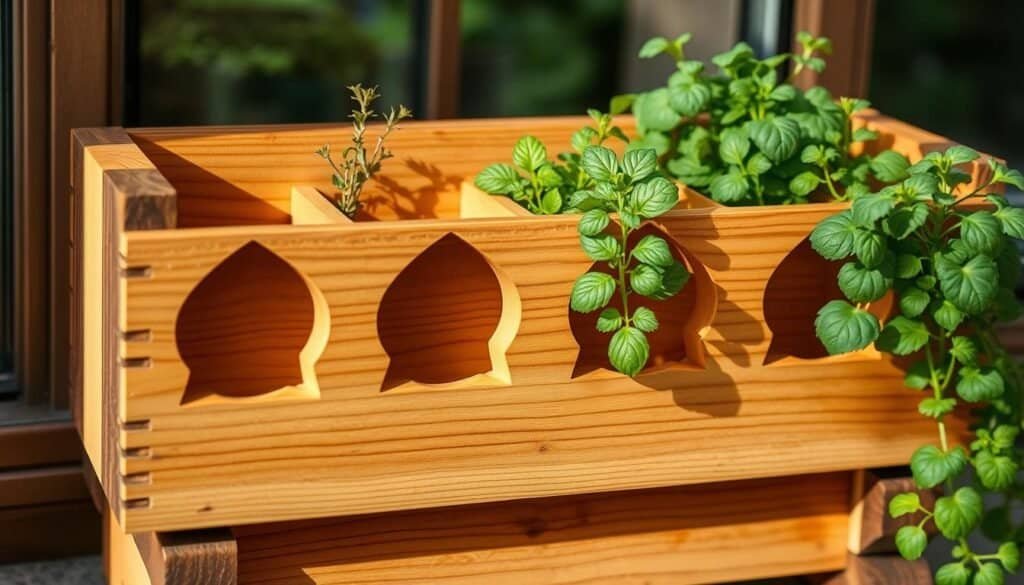
By following these steps, you can make a useful and nice-looking wooden herb planter box. This DIY project adds greenery to your home and gives you fresh herbs whenever you need them.
Decorative Wooden Flower Stand for Multiple Pots
Building a decorative wooden flower stand for multiple pots is a fun DIY project. It lets you show off your favorite plants and add elegance to your home.
First, think about the design of your flower stand. You can pick a simple or detailed design, depending on your skill and taste. You can use wood like oak, pine, or cedar. Make sure the wood is strong and can handle both indoor and outdoor use.
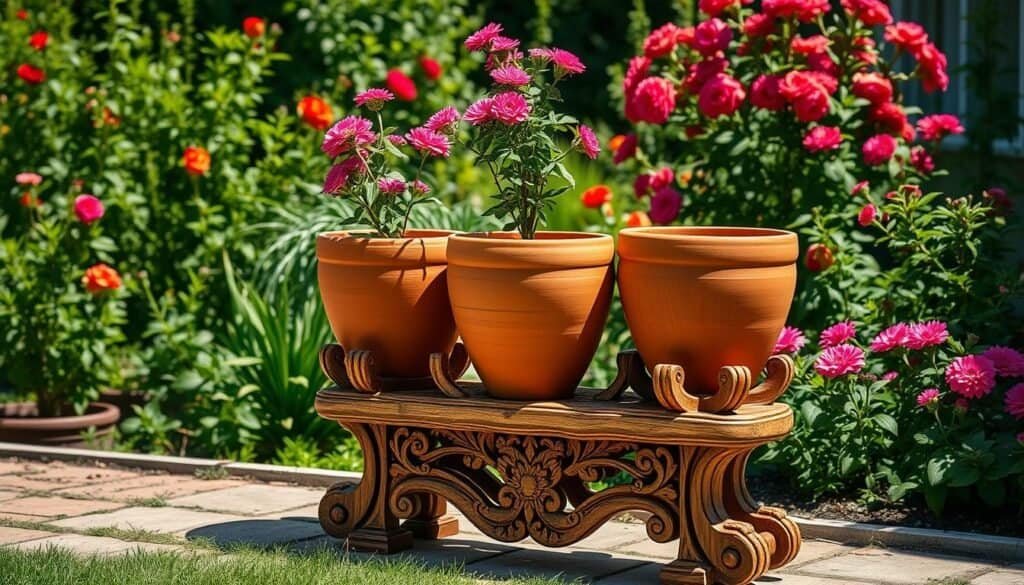
You’ll need wooden planks, a saw, a drill, and screws to start. You might also need a hammer, sandpaper, and a waterproof sealant to protect the wood. The steps include measuring and cutting the wood, building the frame, and adding the shelves.
You can customize your stand to fit your space and style. You can make it with multiple tiers for several pots or a simple one-tier stand. You can stain or paint it to match your home’s decor.
By following these steps and using the right materials, you can make a beautiful wooden flower stand. It will showcase your plants and add warmth to your home.
Wooden Pallet Vertical Garden Planter
Creating a wooden pallet vertical garden planter is a great way to reuse old pallets. It brings greenery into your home. This project also helps reduce waste and adds nature to your space.
When picking a pallet for your garden, safety is key. The pallet should be free from chemicals and debris. Look for “HT” (Heat Treated) pallets as they are safer than “MB” (Methyl Bromide) ones.
Safety Considerations for Pallet Selection
Make sure the pallet is sturdy and in good shape. Avoid pallets with broken or rotten wood. They can’t hold the weight of soil and plants.
Disassembly and Cleaning Methods
To take apart the pallet, you’ll need a hammer and a pry bar. Gently pry off the planks without damaging them. Clean the planks well with a wire brush to get rid of dirt or debris.
After cleaning the planks, start building your vertical garden. Stack the planks in a staggered pattern for layers. Use screws or nails to hold them together, making sure it’s stable.
Fill the planter with quality potting mix and plant your greenery. Water the plants often. Enjoy the beauty of your wooden pallet vertical garden.
Conclusion: Bringing Nature Indoors with Your Handcrafted Wooden Planters
Making handcrafted wooden planters is a fun DIY project. It makes your home look better and feels more welcoming. By adding plants indoors, you can make the air cleaner, feel less stressed, and be happier.
There are many creative projects to try, from simple boxes to fancy stands. These projects are great for all skill levels. You can make something that matches your home and style.
Whether you’re experienced or new to woodworking, making your own planters is rewarding. You get to make something beautiful and help the environment. So, start your DIY adventure and bring nature inside with your own wooden planters.

